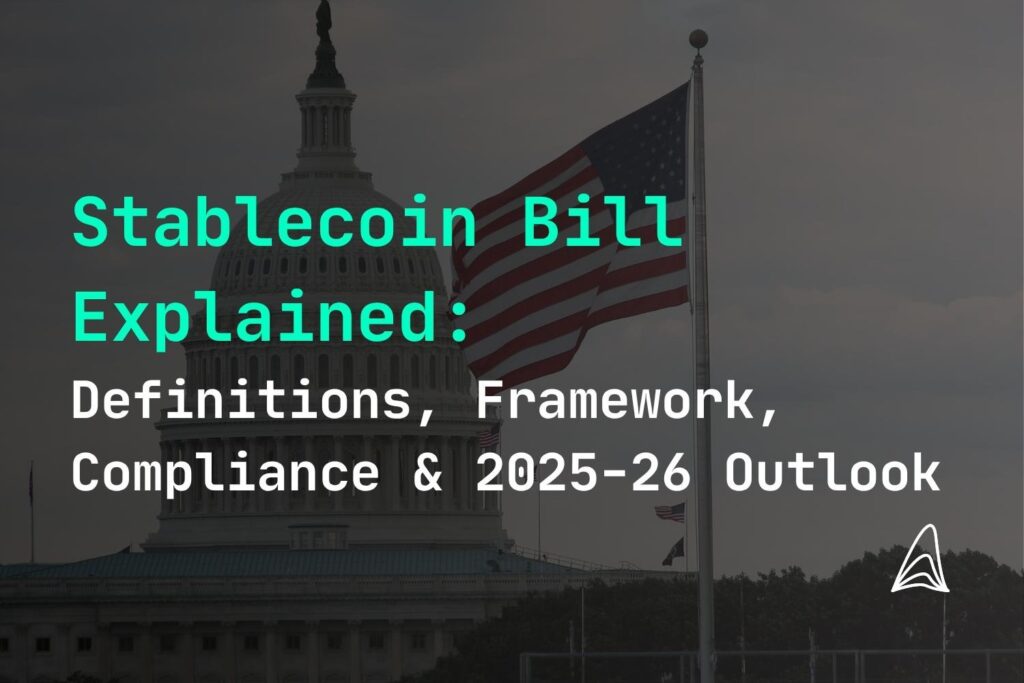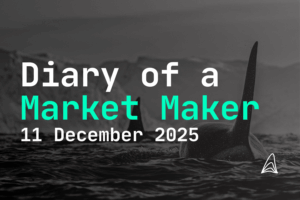
- Jakob Brezigar
- Updated: July 17, 2025
- Reading time: 6 min
Stablecoin Bill Explained: Definitions, Framework, Compliance & 2025‑26 Outlook

What is a stablecoin bill and why it matters?
- Defining “payment stablecoins” (tokens redeemable for a fixed amount).
- Setting issuer standards —licensed entities, reserve backing, audits, disclosures.
- Assigning regulatory oversight, federally or at the state level.
How does the current US stablecoin bill framework work?
What does the GENIUS Act require?
- Full 1:1 fiat or liquid asset reserve, with monthly public disclosures and annual independent audits.
- Issuers must be federally chartered banks or eligible nonbanks, with state-federal supervision; state issuers crossing $10B issuance must transition federal.
- Clear legal status —stablecoins are neither securities nor commodities under this bill.
- Consumer-protection and AML compliance —reserves must be auditable; enforcement aligned with Bank Secrecy Act.

What other compliance or frameworks apply globally?
How does US policy compare to EU MiCA and Asian approaches?
- EU MiCA became fully effective December 2024, requiring licensure, reserve transparency, consumer protection and governance rules for stablecoins.
- UK framework under FCA and PRA is evolving, leaning on Basel standards for risk treatment.
- Asia / Hong Kong: licensing takes effect August 1, 2025. Chinese tech giants (JD, Ant) are preparing renminbi and HK dollar stablecoins to support yuan internationalization.
What are the main KPIs and risk metrics for stablecoin issuers?
- Reserve ratio (e.g., 100% fiat/liquid asset backing).
- Transparency metrics: monthly reserve compositions, audit reports, redemption time SLA.
- Liquidity stress tests: run periodic on‑chain redemption drills.
- Counterparty risk: rated assets only; exclude volatile crypto reserves (e.g., Bitcoin, gold).
- Compliance KPI: AML thresholds, suspicious activity reports, regulatory inspections.
What are current trends and the 2026 outlook?
Which developments mark 2025 and what lies ahead?
- US “Crypto Week” planned by House Republicans (July 2025) to vote on GENIUS, Clarity & anti‑CBDC acts.
- Ripple, Circle and Anchorage seeking bank-charters to manage reserves directly with the Fed.
- Tether, with $156 B circulation, faces pressure due to opaque practices, but may adjust or exit US market.
- Corporate usage ramp-up: PayPal, Amazon, Walmart exploring stablecoin payments for lower fees and real-time settlement.
- Global CBDC pressure: BIS and central banks continue evaluating stablecoins as part of next-gen monetary systems.

Why Orcabay is well‑positioned to help
- Algorithmic market‑making: providing on‑chain liquidity while monitoring regulatory constraints
- Exchange partnerships: working with chartered entities to ensure compliance
- Treasury/back‑reserve optimization: integrating compliance KPIs with yield assets under regulatory limits
Conclusion
Disclaimer: The information provided in this article is for informational purposes only and does not constitute financial, investment, or other professional advice. All opinions expressed herein are solely those of the author and do not represent the views or opinions of any entity with which the author may be associated. Investing in financial markets involves risk, including the potential loss of principal. Readers should perform their own research and consult with a licensed financial advisor before making any investment decisions. Past performance is not indicative of future results.

Jakob Brezigar
Jakob, an experienced specialist in the field of cryptocurrency market making, boasts an extensive international presence. With Orcabay, he has skillfully managed major operations and deals for a wide array of global stakeholders.



